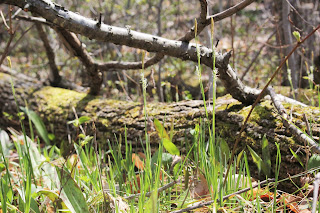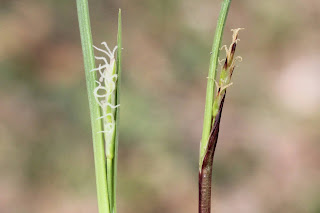Yesterday, after an excellent morning of watching migrant birds (highlighted by over 500 Northern Flickers), I went down to Ipperwash in search of Olympia Marbles. My friend Isabel was with me, as it would be a new butterfly for the both of us.
Not five minutes after pulling into the MNR parking lot (probably the bumpiest parking lot in Lambton County? Maybe Southwestern Ontario?), we found our target. There ended up being several individuals, which was a treat to see.
There were a few Common Green Darners flying around as well, my first of the year, and probably my earliest ever. I managed to catch one. So far my 2021 swing to catch ratio is about 4:1, hopefully that improves as I dust off my skills...
A few plants of interest in the dunes.
 |
| Bearberry (Arctotaphylos uva-ursi) |
 |
| Lyreleaf Rockcress (Arabidopsis lyrata) |
 |
| Rock Sandwort (Sabulina michauxii) |
I also found this lichen. Pretty sure it is Sand-loving Iceland Lichen (Cetraria arenaria).
We went to the dunes and swales afterwards for a quick walk. We found another Olympia Marble, as well as come Cabbage Whites. I was hoping to finally get a Brown Creeper for Lambton, but nope...where are they?? I took photos of a couple plants of interest. I will have to come back for some more dedicated botanizing.
 |
| Wintergreen (Gaultheria procumbens) |
 |
| Parasol Sedge (Carex umbellata) |
Afterwards, I parted ways with Isabel and started on my way home. I planned to stop into the Parkhill CA on the way for a bit to look for plants, so that is what I did.
As soon as I got out of the car I heard a Ruffed Grouse drumming, and later heard a second. Nice to know they are here!
I made my way down into the ravine. The plants have really come along since I was there two weeks ago. Several species of native wildflowers were seen.
 |
| Yellow Trout-lily (Erythronium americanum) |
 |
| Large White Trillium (Trillium grandiflorum) |
 |
| Twinleaf (Jeffersonia diphylla) |
 |
| Cut-leaved Toothwort (Cardamine concatenata) |
 |
| Dutchman's Breeches (Dicentra cucullaria) |
Sharp-lobed Hepatica (Hepatica acutiloba) was one of the more abundant flowers. What a showstopper, it comes in a variety of colours.
Canadian Wild Ginger (Asarum canadense) was beginning to bloom. The flowers lie on the ground, and this is because it is pollinated by ants.
There were quite a few sedges (Carex spp.) seen, and a few were identifiable to species. One of these was Long-stalked Sedge (Carex pedunculata). The long "stalks" (peduncles) were obvious on the plants which were further along. Another good way to identify this sedge is that the leave apices (tips) come to a sudden point, whereas in other species, the leaf comes to a sharp point more gradually.
Pretty Sedge (Carex woodii) lives up to its common name. This is a species that I have really overlooked in the past. While I have seen this species once before (I recently realized I misidentified a sedge from a couple years back that was this species), this is the first time I have really appreciated and studied it in the field. This isn't a super abundant species, but can be common in the right habitats.
Of course, Carey's Sedge (Carex careyana) was a highlight. This is a pretty rare sedge that I saw for the first time a couple weeks ago at this location. It is much further along now.
It could be confused with Plantain-leaved Sedge (Carex plantaginea), which also has wide leaves, and is the same taxonomic section, Carex sect. Careyanae. While the leaves are pretty distinct once you get a feel for them (typically a little less wide, and are noticeably unwrinked), if you can see the culms (the "stem" with the flowers), there is an easy way to tell them apart: the bracts. In Carey's Sedge, the bracts (a specialized leaf) subtending (below) the pistillate spike (female flowers) is green (although sometimes there can be a hint of red at the base) and leafy, and in Plantain-leaved Sedge, this bract is red and basically non-existent—there isn't really a leafy bit. Below is a comparison showing this, Carey's Sedge on the left, and Plantain-leaved Sedge on the right.
I am looking forward to keeping tabs on this population as the plants begin to mature!
I also finally, after scouring the ravine for over an hour, stumbled across some Harbinger-of-spring (Erigenia bulbosa), my first time seeing this uncommon to rare in Ontario species (I have gone out about four times this spring looking!). Unfortunately, it was past flowering, and there were only like four plants. I was pleased, but admittedly a bit disappointed to have missed it in flower. I must have walked right by these plants when I was here a couple weeks ago.
I ended up taking the long way back to the car. Pretty uneventful, but I got a nice view of Mud Creek.
Today, I had a tip on where to look for another population of Harbinger-of-spring in the Coldstream CA, so that is where I went. I hoped it would be in flower.
It took a bit of scouring, but finally I spotted some. This is a pretty small species, and is quite easily overlooked. Had I not stopped to look at a Carey's Sedge plant (more on that later), I probably would have missed them!
Luckily for me, there were still lots of flowers present, although the plants were past their peak.
I found some more Pretty Sedge as well. Must be indicative of good habitat.
With all the recent warm weather (it got up to at least 18 degrees today, and around 25 degrees yesterday), plants are way ahead of schedule. The forest floor looked like it was at least late April, maybe even early May. I am certainly not complaining, it was a long winter!
 |
| Wood Anemone (Anemonoides quinquefolia) |
 |
| Mayapple (Podophyllum peltatum) |
 |
| Red Trillium (Trillium erectum) |
 |
| Twinleaf |
 |
| Dutchman's Breeches |
 |
| White Trout-lily (Erythronium albidum) |
 |
| Common Blue Violet (Viola soria) |
I left Coldstream quite happy :)
On my way home, I quickly checked on a population of False Rue-anemone (Enemion biternatum), another rare species in Ontario. In more or less full bloom, as expected this year I guess! This is one of my favourite early spring species.
Things might come to a bit of a standstill with this week's weather forecast, but it won't be long now—great things are ahead!








































































